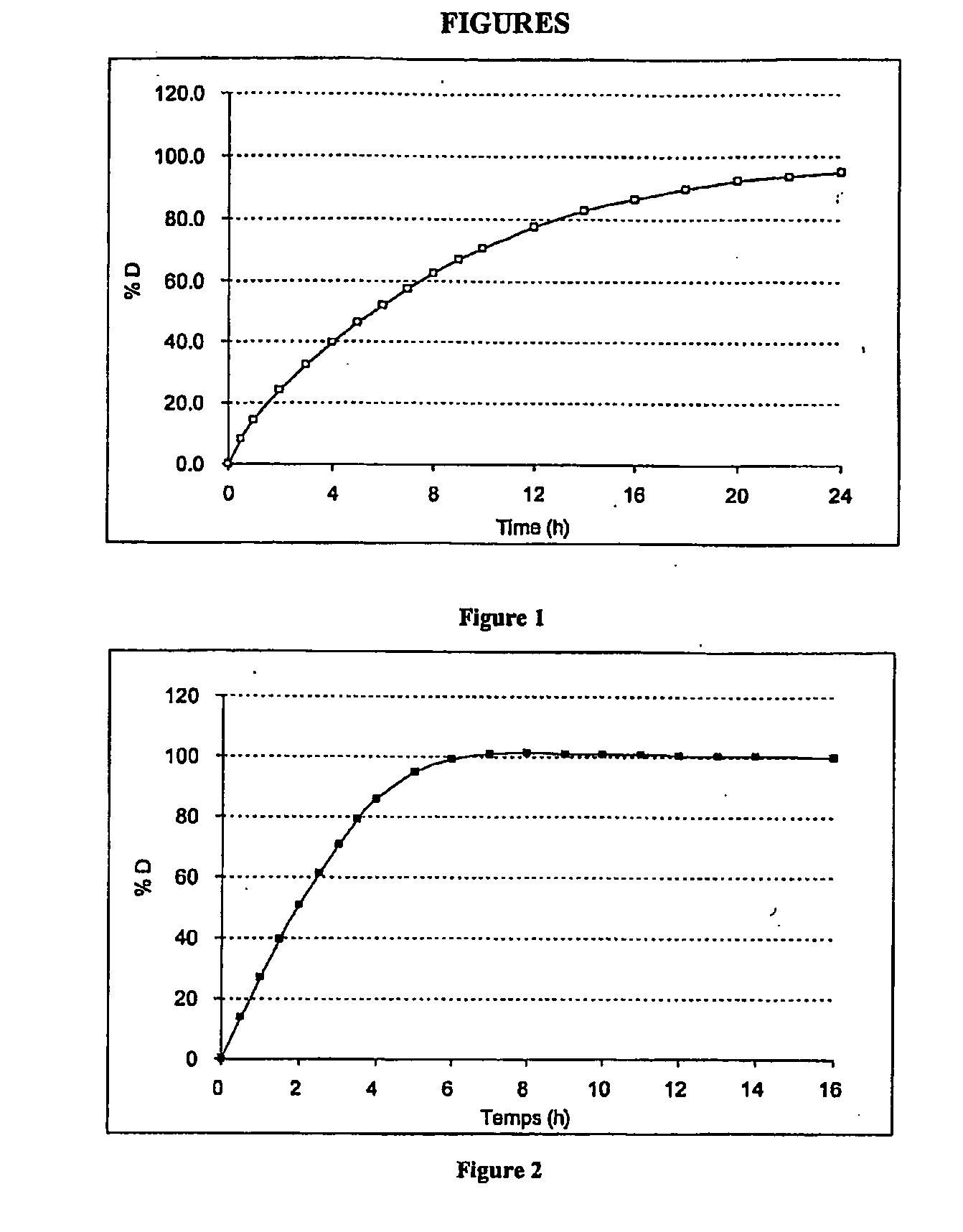Novel acetysalicylic acid formulations
a technology of acetysalicylic acid and formulation, applied in the direction of biocide, drug composition, extracellular fluid disorder, etc., can solve the problems of inability to regenerate cox, aspirin overflow, and platelets are especially susceptible to aspirin mediated irreversible inactivation of cox, etc., to reduce the risk of thrombotic cardiovascular events
- Summary
- Abstract
- Description
- Claims
- Application Information
AI Technical Summary
Benefits of technology
Problems solved by technology
Method used
Image
Examples
example 1
Preparation of Controlled-Release Aspirin-Based Microcapsules
[0107]66 g of ethyl cellulose (Ethocel 7 Premium / Dow), 7 g of Plasdone K29 / 32® (povidone / ISP), 8 g of castor oil, 9 g of magnesium stearate and 10 g tartaric acid are dispersed in 1200 g of a mixture made of 60% of isopropanol & 40% of acetone. The suspension is sprayed on 900 g of acetylsalicylic acid (aspirin) crystals, previously sieved between 200 and 500 μm.
[0108]These microcapsules have been tested in a pH 6.8 (KH2PO4 0.05M / NaOH) dissolution medium maintained at 37° C. and stirred with a paddle speed of 100 rpm (USP II apparatus) (See FIG. 1).
example 2
Preparation of Controlled Release Omeprazole Based Microcapsules
[0109]Step 1: 700 g of omeprazole and 100 g de Klucel EF® (hydroxypropyl cellulose / Aqualon) are dispersed in 3000 g of isopropanol. The suspension is sprayed on 200 g of neutral microspheres (Asahi-Kasei) in a spray coater Glatt GPCG1.
[0110]Step 2: 50 g of ethyl cellulose (Ethocel 20 Premium / Dow), 20 g of Plasdone K29 / 32® (povidone / ISP), 20 g of Lutrol F-68 (poloxamer 188 / BASF) and 10 g of castor oil are dispersed in mixture made of 60% of isopropanol and 40% of acetone. This solution is sprayed on 900 g of omeprazole granules (prepared at step 1).
[0111]The obtained microparticles are filled into a size 3 gelatin capsule. The dose of omeprazole per capsule is, in this test, 80 mg i.e. 127 mg of microcapsules. These microcapsules have been tested in a pH 6.8 (KH2PO4 0.05M / NaOH) dissolution medium maintained at 37° C. and stirred with a paddle speed of 100 rpm (USP II apparatus). (See FIG. 2).
example 3
Preparation of Immediate Release Lansoprazole-Based Microcapsules
[0112]900 g of lansoprazole & 100 g of Klucel EF® (hydroxypropyl cellulose / Aqualon) are previously dry-mixed in a high shear granulator (Aeromatic PMA1) for 5 minutes. This mixture is then granulated with water (180 g). The granules are dried at 40° C. in ventilated oven, and calibrated on 500 μm sieve. The fraction 200-500 μm is selected by sieving.
[0113]These microcapsules have been tested in a pH 6.8 (KH2PO4 0.05M / NaOH) dissolution medium maintained at 37° C. and stirred with a paddle speed of 100 rpm (USP II apparatus) Their release is immediate.
PUM
| Property | Measurement | Unit |
|---|---|---|
| Fraction | aaaaa | aaaaa |
| Fraction | aaaaa | aaaaa |
| Fraction | aaaaa | aaaaa |
Abstract
Description
Claims
Application Information
 Login to View More
Login to View More - R&D
- Intellectual Property
- Life Sciences
- Materials
- Tech Scout
- Unparalleled Data Quality
- Higher Quality Content
- 60% Fewer Hallucinations
Browse by: Latest US Patents, China's latest patents, Technical Efficacy Thesaurus, Application Domain, Technology Topic, Popular Technical Reports.
© 2025 PatSnap. All rights reserved.Legal|Privacy policy|Modern Slavery Act Transparency Statement|Sitemap|About US| Contact US: help@patsnap.com

